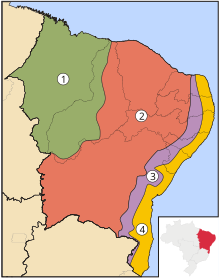Sertão

The Sertão ( Portuguese serˈtɐ̃w̃ ) describes the semi-desert landscapes in inland Brazil . It is one of the four sub-regions of the Northeast Region ( Região Nordeste do Brasil ) with the highest area share. It stretches across the states of Alagoas , Bahia , Ceará , Paraíba , Pernambuco , Piauí , Rio Grande do Norte and Sergipe , down to the meso regions of Norte de Minas and Vale do Jequitinhonha in the state of Minas Gerais .
In the center and south of the country it is overgrown with tree savannah , the northeast is shrub savannah interspersed with deciduous trees. The region is characterized by very little rainfall and is often affected by drought ; the dry season is ten to eleven months. The annual precipitation is mostly below 300 mm and reaches its minimum in Petrolina on the Rio São Francisco with 213 mm. Only a few animals such as the anteater or the armadillo are sufficient today to live in this region.
To the Atlantic lies between the Sertão and the forest zone ( Mata Atlântica ) as a transition area the agreste , in the west the transition region between the arid area and the rainforests of the Amazon basin is called meio norte .
Extensive cattle farming and large estates predominate, although today only one cattle per 10 hectares can be kept on the dry soils . Around 1700, over a million animals of all kinds are said to have grazed here - cattle hides were the region's main export item - which accelerated desertification. From March / April to November / December, herd migrations into the more humid hill and mountain areas are common. Agriculture is only possible in isolated cases. Some source areas and moisture-collecting valley areas form relatively fertile islands, the so-called brejos , in which the smallholder population is concentrated and which make up a total of around 18,000 km² in the northeast. Around 500,000 ha are irrigated, around 2.5 million ha would be possible.
Social structure and folklore
The land ownership and social structure, especially in the northeast, is characterized by extreme contrasts. Sometimes one can still speak of feudal structures or even of modern slavery .
The Sertanejos have produced a diverse folklore that has long survived in the underdeveloped region without being bothered by modernization. The Música sertaneja (Brazilian Country) is a cultural product of the Sertão in southern Brazil.
The cangaceiros
Cangaceiros were members of marauding gangs in the Sertão. The most important and well-known leader was Virgulino Ferreira da Silva , called Lampião (lamp, lantern) during the 1920s / 30s. His person and gang have been glorified and exaggerated over the decades. Comparisons were made to Robin Hood , but they were not compatible with reality. The story of the Cangaceiros was processed on film ( O Cangaceiro - The Outlaws ). The “hymn” of the Cangaceiros Mulher Rendeira , which is still sung in the sertão today and which Helmut Zacharias successfully transferred to German musical heritage, has also become known.
Representation of the sertão in literature
The romantic poet Antônio Gonçalves Dias , who also researched the Indian languages and myths, contributed to the mythization of the Sertão and the creation of the Brasiliade in the second half of the 19th century. The geographic-historical-poetic essay Os Sertões: Campanha de Canudos by the engineer and journalist Euclides da Cunha on the suppression of the landless revolt in the Canudos settlement caused a sensation when it appeared in 1902 and has since been considered “far beyond the educated as a canonical, identity-creating work, as the most representative book of Brazil, as the 'Bible of the Nation' ”. Also known were the book Grande Sertão: Veredas by João Guimarães Rosa (1956) and the novel Vidas secas (1938; Eng . "Karges Leben" 2013) by Graciliano Ramos , which was made into a film in 1963 under the direction of Nelson Pereira dos Santos . In Germany it was published under the title “After Eden it's far”.
